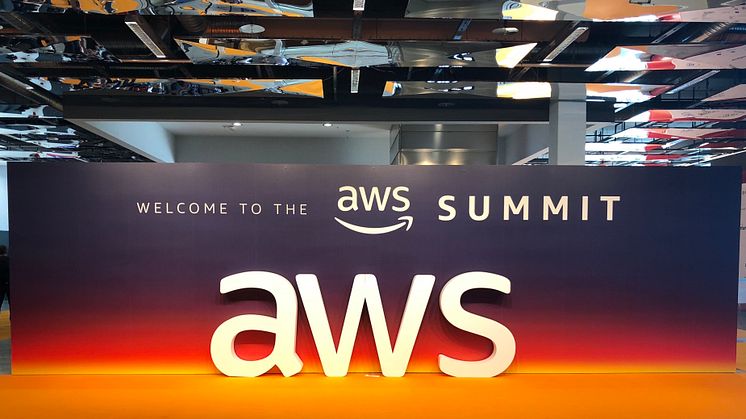
Blog post -
AWS Summit 2018 in Stockholm, Sweden’s New Biggest Tech Event
Amazon Web Services, or AWS in short, is at the center of the digitalisation of everything, and AWS Summit in Stockholm is Amazon’s biggest Nordic event with over 5,000 visitors. The endless line to the registration desk is proof alone that this is probably now Sweden’s largest annual tech event. The reason, of course, is that 2018 is the year AWS, the world’s largest cloud, is launching three new data centers in the Stockholm region, to serve all of the Nordics.
Judging from the audience, AWS Summit is attracting a wide range of stakeholders, from developers and engineers, to entrepreneurs, corporate management and venture capital. Everybody’s here to engage in one way or the other with the most expansive company in the world at the moment, the unstoppable Amazon. Standout Capital was on location.
The event is a combination of exhibition with AWS partners like NetApp, Cloudability, Snowflake, RedBridge and Opsio – and seminars on such topics as “Serverless computing”, “Building Your Data Lake on AWS”, “Machine Learning”, “Harness the power of infrastructure as code”, “Scaling From Zero to Million Users” and “How to be a fintech startup in the cloud”.
But let’s start with some figures about AWS (the cloud business of Amazon). AWS now has a leading 35% market share of the global public cloud market, ahead of its main competitors Microsoft Azure, Google Cloud Platform and Alibaba Cloud. And AWS is getting bigger, currently growing with 46% year-on-year with a $22 billion annual revenue run rate. That’s about 12% of Amazon’s $178 billion revenue. With millions of customers in 18 regions currently with 55 Availability Zones, or AZs, (which is another word for data center) across the planet (with 4 new regions and 12 more Availability Zones coming soon), AWS is expanding its global network.
The most impressive aspect of AWS is the pace of innovation. Last year AWS added 1,430 new capabilities (or features, functions and products) to its cloud. While the old world of hosting was about storing data, the new cloud offers everything you need to run a modern business like machine learning and analytics, all delivered as a service.
In the Nordics, AWS is now launching three new Availability Zones (AZ) in 2018, located in Katrineholm, Eskilstuna and Västerås. From these facilities, AWS will offer low latency networks other services across all Nordic capitals, Stockholm, Helsinki, Oslo, Copenhagen as well as the Baltic states. Low latency is a big deal in the digitised society. It’s essentially a computer network that is optimized to process a very high volume of data messages with minimal delay (latency). These networks are designed to support operations that require near real-time access to rapidly changing data. So AWS is well positioned to meet the high demands of the Nordic region’s most advanced tech companies.
“Cloud is the new normal”, says Guido Bartels head of AWS Nordics. Amazon expects the market to understand that using all the features of a public cloud is a cost-efficient, secure and operationally innovative way to run a business going forward. In addition, all the three data centers in Sweden will run on renewable energy. And AWS promises “data sovereignty”, in essence meaning that no foreign power can mess with your data, as AWS offers an alternative to the local private clouds. However, it’s still unclear what the US Cloud Act, that gives US government the right to snoop into clouds, will mean in this perspective. Anyway, the Nordic organization is established with offices in Stockholm, Copenhagen and Helsinki and is fast growing org with local employees.
Keynote, Werner Vogels is the CTO of Amazon. Not only AWS, but the entire Amazon. He’s in charge of the technology vision and architecture of one of the world’s biggest technology companies. It’s clear that he loves AWS and its customer offerings. It’s maybe useful to see AWS as a collection of powerful capabilities and features. “We want to offer the best tools to build your own house”, says Vogels. But AWS will not instruct you how to build the actual house, that’s up to you. So, what are the tools? It’s a great deal about code.
First, you have to rethinking the “code value chain” and traditional development (write code > check in the code > build > test > deploy > operate). WIth AWS Cloud 9, it’s now easier to write the code and immediately operate the applications.
Second, you can use AWS’ ready-made applications. Let’s start with Machine Learning and AI, probably one of the main topics for any digital company today. What does it mean? It’s all mostly about predicting the future, but as we all know, no-one can predict the future. You can, however, take data from the past and make a pretty good estimate. That’s Machine Learning, and as a consumer you are likely to encounter it as recommendations on Amazon, Netflix and Zalando.
Amazon has a long history of Machine Learning, but there is a apparent urge to get even better, use more data, offer more applications. The fight is on with the other AI-giants like Google and Alibaba. AWS’ mission is to “put Machine Learning in the hands of every developer and data scientist”. Again, it’s all about offering powerful tools to build your business. Amazon SageMaker is a collection of Machine Learning models and algorithms available. Other tools include Amazon face recognition, photo and video analysis, applications for speech & hearing and text processing.
In essence, AWS is moving the hosting industry from data storage to capabilities. It also shows how this development will play out. Companies will have various needs, and solve those needs with a combination of on-premises solutions (for sensitive data), local private clouds (for other less-sensitive data) and public clouds like AWS to apply tools like Machine Learning on the data for better customer experience. Thus, the future is a hybrid of clouds. Simultaneously, a new service and consulting market is emerging, to enable companies make use of the vast range of tools and opportunities available. Some of these AWS-partners in the Nordic eco-system were also present at the summit, for example the Nordic cloud specialist Nordcloud from Finland.
Other tools and capabilities in the huge AWS cloud includes Amazon Aurora, for migrating databases to AWS. Amazon S3, AWS Glue offers data lakes and analytics tools. But the most exciting development might be serverless and the elimination of infrastructure management. “Builders want to build, not manage clusters”, says CTO Vogels. Computing is moving from from server to serverless (Virtual Machines -> Containers -> Serverless). Some of the companies that are now running serverless on AWS are Tobii, Daniel Wellington, Telenor, Husqvarna and Reuters.
However, the lasting impression that Werner Vogels, the CTO of Amazon, wants to make, is security. “Security is everyone’s job”, he says. Systems are becoming increasingly vulnerable in a digital world, and one of the most efficient ways to solve it is encryption. AWS offers a feature called “Ubiquitous Encryption”, and Vogels thinks everyone should use it, at least when it concerns customer data. This is a new take on the European Union’s new GDPR directive, that forces companies to have policies to protect data. Amazon and Vogels obviously think it’s better to let technology (encryption) protect sensitive data.
Who are AWS’ customers? No tech evangelist event is complete without convincing customer testimonials. AWS offered no less than three visionary and happy clients.
Soili Mäkinen is the CIO of CargoTec, a Finnish company in the global container cargo business, operative in 100 countries with 11,000 employees and €3.2 billion revenue. CargoTec handles 25% of the world’s cargo traffic, which involves extreme logistic challenges at container terminals. The challenges include lack of central overview or transparency, planning for maximum utilisation of capacity, resulting in moving empty containers across the globe and an estimated €17 billion annual inefficiency. With AWS, CargoTec built a digitalised platform to make sense of data from multiple source like shipping companies and harbour operators, creating automation and modern intelligent cargo handling.
Christine Stanley is the head of clinical laboratory at WuxiNextCode, a global network for rare diseases, connecting patients. The purpose is make connections to accelerate diagnosis, and the need is to store, analyse and share massive amounts of data. There are around 500 million patients in the world with rare diseases, that means 1 of 15 people. Each human being in the world represent one set of DNA, or genome, which equals 100 gigabyte. 500 million people thus represents 50 exabyte of data. With the AWS partnership, WuxiNextCode could analyse 100,000 genomes in under 1 minute. As Christine Stanley says, “The Internet of DNA 2.0 is about connecting people and genomes.”
Heikki Verta is head of engineering at Supercell, a global games company, now running 4 games globally on 5000 servers with 5 terabyte data per day, enjoyed by 100 million daily users. Heikki says that Supercell has a simple philosophy, ”The best teams make the best games”. The company today has 250 “supercellians”, with about 20 people in each team. In short, the success is based on the best people, the right culture, and an optimal platform. Of course, Supercell runs an efficient operation on AWS.
As Amazon’s CTO Vogels points out, the 5 pillars of a well-designed architecture is operational excellence (offering the right tools), security & compliance, reliability, performance efficiency and cost optimization. On that last note, there is now a new market for cloud optimization tools emerging, just like the emerging market for Google AdWords and pay-per-click triggered an industry of bid-management tools, of which most are gone now. The need for third-party optimization tools is driven by the fact that a traditional hosting market with fixed pricing, is now transforming into a “financial market” where customers buy IT as services with variable pricing on demand.
The reason why Amazon and AWS will be a key player in the Nordic hosting and cloud market, is that they offer a business model and set of features & tools that are game changing, and in a good position to attract both customers and developers. And that’s why 5,000 people are flocking to AWS Summit 2018 in Stockholm to learn more. However, both Google and Microsoft Azure are very active in the market and competition for customers is expected to be fierce, especially since Microsoft has a traditionally dominant position in the Nordics. Both Google and Microsoft are also adding new capabilities to their clouds, elebit not at the frenetic pace of Amazon. AWS Nordic launches their three Swedish data centers in the fourth quarter 2018, and be prepared that the Nordic cloud market will go crazy from the beginning of 2019.

